Docker & Kubernetes 2 : minikube Django with Postgres - persistent volume
Continued from the previous Kubernetes minikube (Docker & Kubernetes 1 : minikube A), we'll use Django with other apps side by side.
Kubernetes version info:
$ kubectl version
Client Version: version.Info{Major:"1", Minor:"11", GitVersion:"v1.11.3", GitCommit:"a4529464e4629c21224b3d52edfe0ea91b072862", GitTreeState:"clean", BuildDate:"2018-09-10T11:44:36Z", GoVersion:"go1.11", Compiler:"gc", Platform:"darwin/amd64"}
Server Version: version.Info{Major:"1", Minor:"10", GitVersion:"v1.10.0", GitCommit:"fc32d2f3698e36b93322a3465f63a14e9f0eaead", GitTreeState:"clean", BuildDate:"2018-03-26T16:44:10Z", GoVersion:"go1.9.3", Compiler:"gc", Platform:"linux/amd64"}
Here is a screen shot output from our initial Django app (kubernetes_django/minikube-2/):
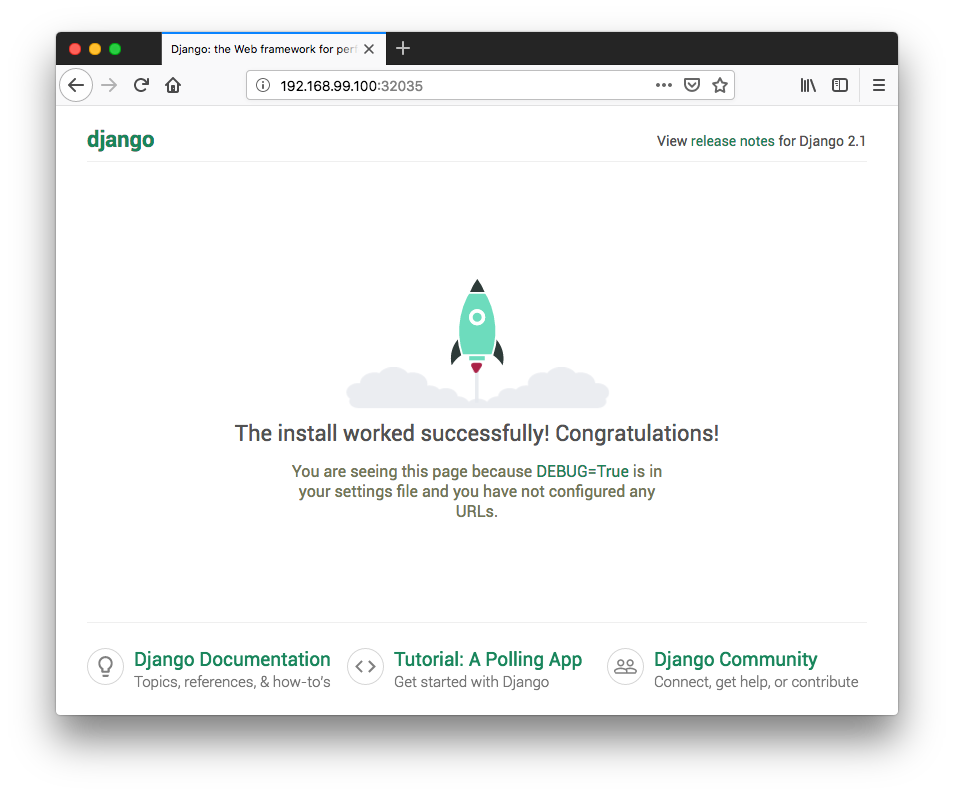
$ docker build -t dockerbogo/django-minikube:1.0.0 . $ docker push dockerbogo/django-minikube:1.0.0 $ kubectl create -f deployment.yaml $ kubectl create -f service.yaml $ minikube service django-service --url
To test if it works with local virtual environment, we need to install (in this case, for Mac):
$ brew install postgres $ pg_ctl -D /usr/local/var/postgres start ... ...listening on IPv4 address "127.0.0.1", port 5432 ...listening on Unix socket "/tmp/.s.PGSQL.5432" done server started $ postgres -V postgres (PostgreSQL) 10.5
Since we installed Postgres from homebrew then we need to run:
$ /usr/local/opt/postgres/bin/createuser -s postgres
$ psql postgres
psql (10.5)
Type "help" for help.
postgres=# \l
List of databases
Name | Owner | Encoding | Collate | Ctype | Access privileges
-----------+-------------+----------+-------------+-------------+-----------------------------
postgres | kihyuckhong | UTF8 | en_US.UTF-8 | en_US.UTF-8 |
template0 | kihyuckhong | UTF8 | en_US.UTF-8 | en_US.UTF-8 | =c/kihyuckhong +
| | | | | kihyuckhong=CTc/kihyuckhong
template1 | kihyuckhong | UTF8 | en_US.UTF-8 | en_US.UTF-8 | =c/kihyuckhong +
| | | | | kihyuckhong=CTc/kihyuckhong
(3 rows)
postgres=# \du
List of roles
Role name | Attributes | Member of
-------------+------------------------------------------------------------+-----------
kihyuckhong | Superuser, Create role, Create DB, Replication, Bypass RLS | {}
postgres | Superuser, Create role, Create DB | {}
postgres=#
Let's set the password for the default postgres account-by default, it has no password:
postgres=# \password postgres Enter new password: Enter it again: postgres=#
Creating DB and change owner:
postgres=# create database kube_django;
CREATE DATABASE
postgres=# \l
List of databases
Name | Owner | Encoding | Collate | Ctype | Access privileges
-------------+-------------+----------+-------------+-------------+-----------------------------
kube_django | kihyuckhong | UTF8 | en_US.UTF-8 | en_US.UTF-8 |
postgres | kihyuckhong | UTF8 | en_US.UTF-8 | en_US.UTF-8 |
template0 | kihyuckhong | UTF8 | en_US.UTF-8 | en_US.UTF-8 | =c/kihyuckhong +
| | | | | kihyuckhong=CTc/kihyuckhong
template1 | kihyuckhong | UTF8 | en_US.UTF-8 | en_US.UTF-8 | =c/kihyuckhong +
| | | | | kihyuckhong=CTc/kihyuckhong
(4 rows)
postgres=# ALTER DATABASE kube_django OWNER TO postgres;
ALTER DATABASE
postgres=# \l
List of databases
Name | Owner | Encoding | Collate | Ctype | Access privileges
-------------+-------------+----------+-------------+-------------+-----------------------------
kube_django | postgres | UTF8 | en_US.UTF-8 | en_US.UTF-8 |
postgres | kihyuckhong | UTF8 | en_US.UTF-8 | en_US.UTF-8 |
template0 | kihyuckhong | UTF8 | en_US.UTF-8 | en_US.UTF-8 | =c/kihyuckhong +
| | | | | kihyuckhong=CTc/kihyuckhong
template1 | kihyuckhong | UTF8 | en_US.UTF-8 | en_US.UTF-8 | =c/kihyuckhong +
| | | | | kihyuckhong=CTc/kihyuckhong
(4 rows)
Virtualenv:
$ virtualenv venv $ source venv/bin/activate (venv) $ pip install -r requirements.txt (venv) $ python manage.py makemigrations (venv) $ python manage.py migrate
After creating the database structure, we can create an administrative account by typing:
(venv) $ python manage.py createsuperuser
We will be asked to select a username, provide an email address, and choose and confirm a password (in this case, I set it to "superuser') for the account.
(venv) $ python manage.py createsuperuser Username (leave blank to use 'kihyuckhong'): django Email address: kihyuck.hong@gmail.com ... Superuser created successfully.
Once we have an admin account set up, we can test if our database is performing correctly by starting up the Django development server:
(venv) $ python manage.py runserver 0.0.0.0:8000
In the web browser, visit the server's domain name or IP address followed by :8000 to reach default Django root page:
http://server_domain_or_IP:8000
We should see the following pages:
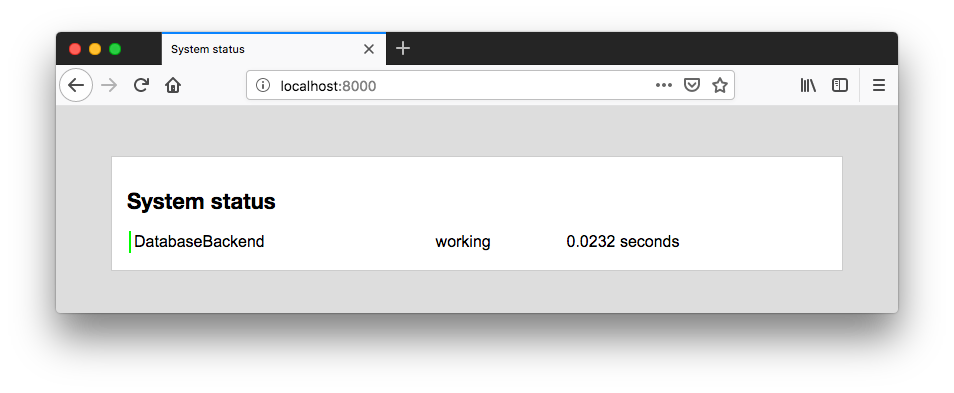
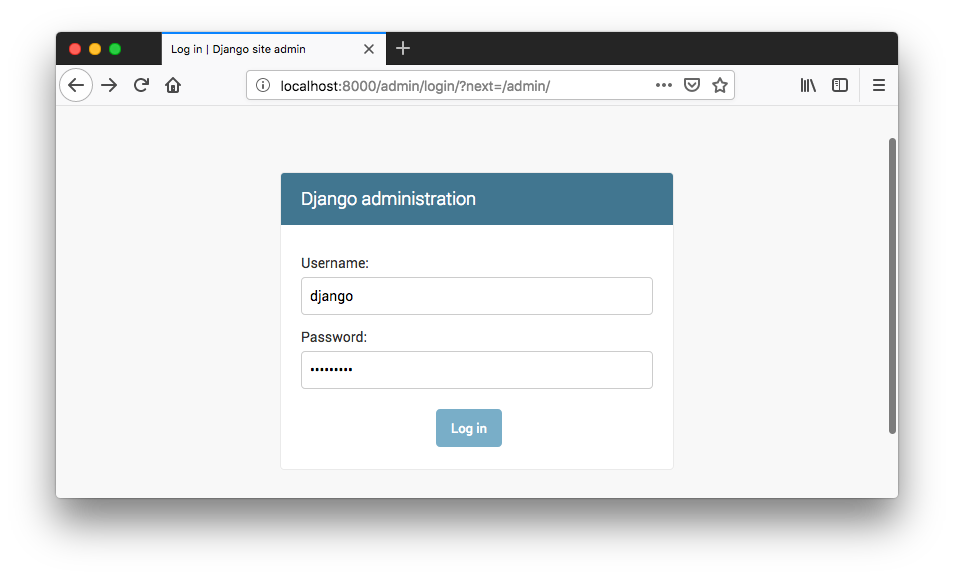
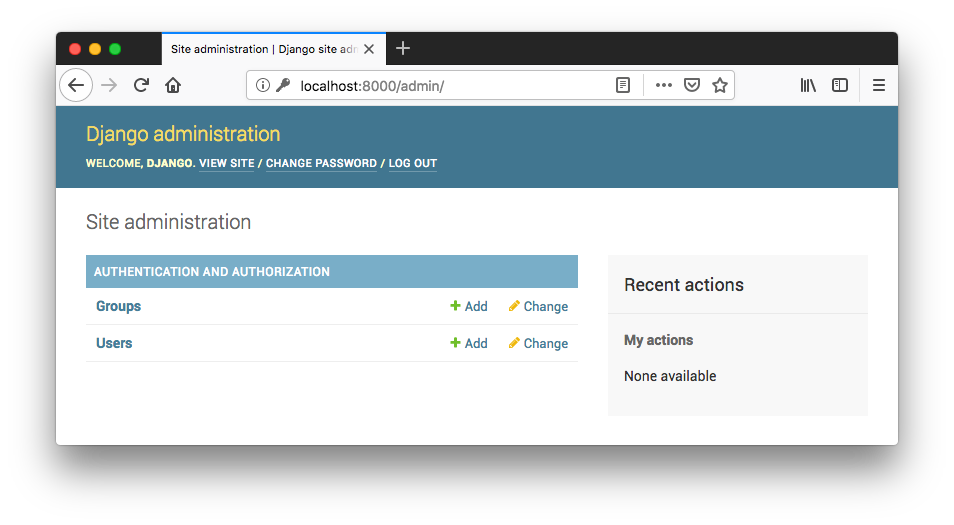
Exit from virtualenv:
(venv) $ deactivate
Start Minikube and to use minikube docker daemon instead of the host docker daemon:
$ minikube start $ eval $(minikube docker-env)
To view the resources on the local cluster, the minikube dashboard can be up by using the command:
$ minikube dashboard
We'll be using the files in kubernetes_django/minikube-2B/.

Let's skip over any details, and just run. We'll go over the details later in this article:
$ docker build -t dockerbogo/django-minikube-2b:1.0.0 . $ docker push dockerbogo/django-minikube-2b:1.0.0 $ kubectl apply -f kube_deploy_postgres/ secret/postgres-credentials created service/postgres-service created persistentvolume/postgres-pv created persistentvolumeclaim/postgres-pvc created $ kubectl apply -f kube_deploy_django/ Warning: kubectl apply should be used on resource created by either kubectl create --save-config or kubectl apply deployment.apps/django configured job.batch/django-migrations created Warning: kubectl apply should be used on resource created by either kubectl create --save-config or kubectl apply service/django-service configured $ kubectl get all NAME READY STATUS RESTARTS AGE pod/django-5fd955498b-4rsbz 1/1 Running 0 10s pod/django-migrations-xssz9 0/1 Completed 0 10s pod/postgres-69c85f5989-s47qz 1/1 Running 0 34s NAME TYPE CLUSTER-IP EXTERNAL-IP PORT(S) AGE service/django-service LoadBalancer 10.98.105.236 <pending> 8000:32035/TCP 10s service/kubernetes ClusterIP 10.96.0.1 <none> 443/TCP 3d service/postgres-service ClusterIP 10.97.164.233 <none> 5432/TCP 34s NAME DESIRED CURRENT UP-TO-DATE AVAILABLE AGE deployment.apps/django 1 1 1 1 10s deployment.apps/postgres 1 1 1 1 34s NAME DESIRED CURRENT READY AGE replicaset.apps/django-5fd955498b 1 1 1 10s replicaset.apps/postgres-69c85f5989 1 1 1 34s NAME DESIRED SUCCESSFUL AGE job.batch/django-migrations 1 1 10s $ kubectl get pv NAME CAPACITY ACCESS MODES RECLAIM POLICY STATUS CLAIM STORAGECLASS REASON AGE postgres-pv 2Gi RWX Retain Bound default/postgres-pvc standard 3m $ kubectl get pvc NAME STATUS VOLUME CAPACITY ACCESS MODES STORAGECLASS AGE postgres-pvc Bound postgres-pv 2Gi RWX standard 3m $ minikube service django-service There is a newer version of minikube available (v0.30.0). Download it here: https://github.com/kubernetes/minikube/releases/tag/v0.30.0 To disable this notification, run the following: minikube config set WantUpdateNotification false Opening kubernetes service default/django-service in default browser...
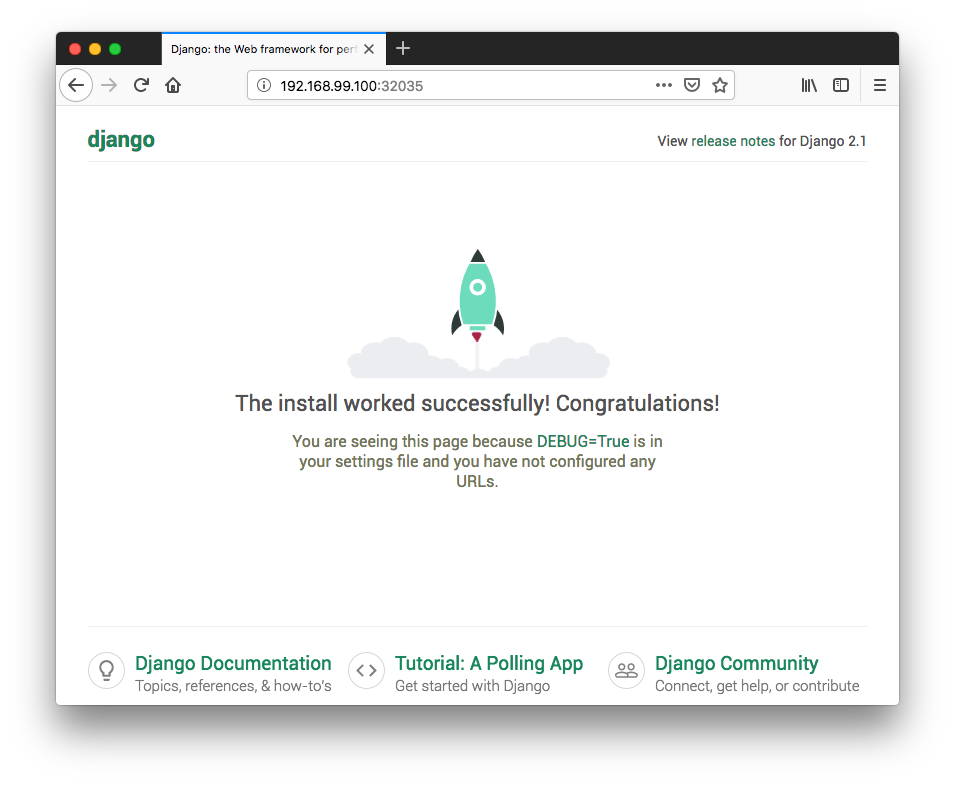
A PersistentVolume (PV) is a storage in the cluster that has been provisioned by an administrator. It is a resource in the cluster just like a node is a cluster resource. PVs are volume plugins like Volumes, but have a lifecycle independent of any individual pod that uses the PV. This API object captures the details of the implementation of the storage, be that NFS, iSCSI, or a cloud-provider-specific storage system.
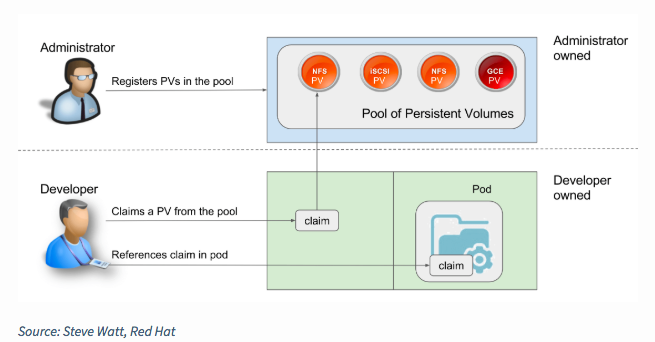
A PersistentVolumeClaim (PVC) is a request for storage by a user. It is similar to a pod. Pods consume node resources and PVCs consume PV resources. Pods can request specific levels of resources (CPU and Memory). Claims can request specific size and access modes (e.g., can be mounted once read/write or many times read-only).
Ref: Persistent Volumes
Kubernetes, Local to Production with Django: 3 - Postgres with Migrations on Minikube
Docker & K8s
- Docker install on Amazon Linux AMI
- Docker install on EC2 Ubuntu 14.04
- Docker container vs Virtual Machine
- Docker install on Ubuntu 14.04
- Docker Hello World Application
- Nginx image - share/copy files, Dockerfile
- Working with Docker images : brief introduction
- Docker image and container via docker commands (search, pull, run, ps, restart, attach, and rm)
- More on docker run command (docker run -it, docker run --rm, etc.)
- Docker Networks - Bridge Driver Network
- Docker Persistent Storage
- File sharing between host and container (docker run -d -p -v)
- Linking containers and volume for datastore
- Dockerfile - Build Docker images automatically I - FROM, MAINTAINER, and build context
- Dockerfile - Build Docker images automatically II - revisiting FROM, MAINTAINER, build context, and caching
- Dockerfile - Build Docker images automatically III - RUN
- Dockerfile - Build Docker images automatically IV - CMD
- Dockerfile - Build Docker images automatically V - WORKDIR, ENV, ADD, and ENTRYPOINT
- Docker - Apache Tomcat
- Docker - NodeJS
- Docker - NodeJS with hostname
- Docker Compose - NodeJS with MongoDB
- Docker - Prometheus and Grafana with Docker-compose
- Docker - StatsD/Graphite/Grafana
- Docker - Deploying a Java EE JBoss/WildFly Application on AWS Elastic Beanstalk Using Docker Containers
- Docker : NodeJS with GCP Kubernetes Engine
- Docker : Jenkins Multibranch Pipeline with Jenkinsfile and Github
- Docker : Jenkins Master and Slave
- Docker - ELK : ElasticSearch, Logstash, and Kibana
- Docker - ELK 7.6 : Elasticsearch on Centos 7
- Docker - ELK 7.6 : Filebeat on Centos 7
- Docker - ELK 7.6 : Logstash on Centos 7
- Docker - ELK 7.6 : Kibana on Centos 7
- Docker - ELK 7.6 : Elastic Stack with Docker Compose
- Docker - Deploy Elastic Cloud on Kubernetes (ECK) via Elasticsearch operator on minikube
- Docker - Deploy Elastic Stack via Helm on minikube
- Docker Compose - A gentle introduction with WordPress
- Docker Compose - MySQL
- MEAN Stack app on Docker containers : micro services
- MEAN Stack app on Docker containers : micro services via docker-compose
- Docker Compose - Hashicorp's Vault and Consul Part A (install vault, unsealing, static secrets, and policies)
- Docker Compose - Hashicorp's Vault and Consul Part B (EaaS, dynamic secrets, leases, and revocation)
- Docker Compose - Hashicorp's Vault and Consul Part C (Consul)
- Docker Compose with two containers - Flask REST API service container and an Apache server container
- Docker compose : Nginx reverse proxy with multiple containers
- Docker & Kubernetes : Envoy - Getting started
- Docker & Kubernetes : Envoy - Front Proxy
- Docker & Kubernetes : Ambassador - Envoy API Gateway on Kubernetes
- Docker Packer
- Docker Cheat Sheet
- Docker Q & A #1
- Kubernetes Q & A - Part I
- Kubernetes Q & A - Part II
- Docker - Run a React app in a docker
- Docker - Run a React app in a docker II (snapshot app with nginx)
- Docker - NodeJS and MySQL app with React in a docker
- Docker - Step by Step NodeJS and MySQL app with React - I
- Installing LAMP via puppet on Docker
- Docker install via Puppet
- Nginx Docker install via Ansible
- Apache Hadoop CDH 5.8 Install with QuickStarts Docker
- Docker - Deploying Flask app to ECS
- Docker Compose - Deploying WordPress to AWS
- Docker - WordPress Deploy to ECS with Docker-Compose (ECS-CLI EC2 type)
- Docker - WordPress Deploy to ECS with Docker-Compose (ECS-CLI Fargate type)
- Docker - ECS Fargate
- Docker - AWS ECS service discovery with Flask and Redis
- Docker & Kubernetes : minikube
- Docker & Kubernetes 2 : minikube Django with Postgres - persistent volume
- Docker & Kubernetes 3 : minikube Django with Redis and Celery
- Docker & Kubernetes 4 : Django with RDS via AWS Kops
- Docker & Kubernetes : Kops on AWS
- Docker & Kubernetes : Ingress controller on AWS with Kops
- Docker & Kubernetes : HashiCorp's Vault and Consul on minikube
- Docker & Kubernetes : HashiCorp's Vault and Consul - Auto-unseal using Transit Secrets Engine
- Docker & Kubernetes : Persistent Volumes & Persistent Volumes Claims - hostPath and annotations
- Docker & Kubernetes : Persistent Volumes - Dynamic volume provisioning
- Docker & Kubernetes : DaemonSet
- Docker & Kubernetes : Secrets
- Docker & Kubernetes : kubectl command
- Docker & Kubernetes : Assign a Kubernetes Pod to a particular node in a Kubernetes cluster
- Docker & Kubernetes : Configure a Pod to Use a ConfigMap
- AWS : EKS (Elastic Container Service for Kubernetes)
- Docker & Kubernetes : Run a React app in a minikube
- Docker & Kubernetes : Minikube install on AWS EC2
- Docker & Kubernetes : Cassandra with a StatefulSet
- Docker & Kubernetes : Terraform and AWS EKS
- Docker & Kubernetes : Pods and Service definitions
- Docker & Kubernetes : Service IP and the Service Type
- Docker & Kubernetes : Kubernetes DNS with Pods and Services
- Docker & Kubernetes : Headless service and discovering pods
- Docker & Kubernetes : Scaling and Updating application
- Docker & Kubernetes : Horizontal pod autoscaler on minikubes
- Docker & Kubernetes : From a monolithic app to micro services on GCP Kubernetes
- Docker & Kubernetes : Rolling updates
- Docker & Kubernetes : Deployments to GKE (Rolling update, Canary and Blue-green deployments)
- Docker & Kubernetes : Slack Chat Bot with NodeJS on GCP Kubernetes
- Docker & Kubernetes : Continuous Delivery with Jenkins Multibranch Pipeline for Dev, Canary, and Production Environments on GCP Kubernetes
- Docker & Kubernetes : NodePort vs LoadBalancer vs Ingress
- Docker & Kubernetes : MongoDB / MongoExpress on Minikube
- Docker & Kubernetes : Load Testing with Locust on GCP Kubernetes
- Docker & Kubernetes : MongoDB with StatefulSets on GCP Kubernetes Engine
- Docker & Kubernetes : Nginx Ingress Controller on Minikube
- Docker & Kubernetes : Setting up Ingress with NGINX Controller on Minikube (Mac)
- Docker & Kubernetes : Nginx Ingress Controller for Dashboard service on Minikube
- Docker & Kubernetes : Nginx Ingress Controller on GCP Kubernetes
- Docker & Kubernetes : Kubernetes Ingress with AWS ALB Ingress Controller in EKS
- Docker & Kubernetes : Setting up a private cluster on GCP Kubernetes
- Docker & Kubernetes : Kubernetes Namespaces (default, kube-public, kube-system) and switching namespaces (kubens)
- Docker & Kubernetes : StatefulSets on minikube
- Docker & Kubernetes : RBAC
- Docker & Kubernetes Service Account, RBAC, and IAM
- Docker & Kubernetes - Kubernetes Service Account, RBAC, IAM with EKS ALB, Part 1
- Docker & Kubernetes : Helm Chart
- Docker & Kubernetes : My first Helm deploy
- Docker & Kubernetes : Readiness and Liveness Probes
- Docker & Kubernetes : Helm chart repository with Github pages
- Docker & Kubernetes : Deploying WordPress and MariaDB with Ingress to Minikube using Helm Chart
- Docker & Kubernetes : Deploying WordPress and MariaDB to AWS using Helm 2 Chart
- Docker & Kubernetes : Deploying WordPress and MariaDB to AWS using Helm 3 Chart
- Docker & Kubernetes : Helm Chart for Node/Express and MySQL with Ingress
- Docker & Kubernetes : Deploy Prometheus and Grafana using Helm and Prometheus Operator - Monitoring Kubernetes node resources out of the box
- Docker & Kubernetes : Deploy Prometheus and Grafana using kube-prometheus-stack Helm Chart
- Docker & Kubernetes : Istio (service mesh) sidecar proxy on GCP Kubernetes
- Docker & Kubernetes : Istio on EKS
- Docker & Kubernetes : Istio on Minikube with AWS EC2 for Bookinfo Application
- Docker & Kubernetes : Deploying .NET Core app to Kubernetes Engine and configuring its traffic managed by Istio (Part I)
- Docker & Kubernetes : Deploying .NET Core app to Kubernetes Engine and configuring its traffic managed by Istio (Part II - Prometheus, Grafana, pin a service, split traffic, and inject faults)
- Docker & Kubernetes : Helm Package Manager with MySQL on GCP Kubernetes Engine
- Docker & Kubernetes : Deploying Memcached on Kubernetes Engine
- Docker & Kubernetes : EKS Control Plane (API server) Metrics with Prometheus
- Docker & Kubernetes : Spinnaker on EKS with Halyard
- Docker & Kubernetes : Continuous Delivery Pipelines with Spinnaker and Kubernetes Engine
- Docker & Kubernetes : Multi-node Local Kubernetes cluster : Kubeadm-dind (docker-in-docker)
- Docker & Kubernetes : Multi-node Local Kubernetes cluster : Kubeadm-kind (k8s-in-docker)
- Docker & Kubernetes : nodeSelector, nodeAffinity, taints/tolerations, pod affinity and anti-affinity - Assigning Pods to Nodes
- Docker & Kubernetes : Jenkins-X on EKS
- Docker & Kubernetes : ArgoCD App of Apps with Heml on Kubernetes
- Docker & Kubernetes : ArgoCD on Kubernetes cluster
- Docker & Kubernetes : GitOps with ArgoCD for Continuous Delivery to Kubernetes clusters (minikube) - guestbook
Ph.D. / Golden Gate Ave, San Francisco / Seoul National Univ / Carnegie Mellon / UC Berkeley / DevOps / Deep Learning / Visualization